Driving in Puglia is a convenient and practical option for getting around our region, whether you’re hopping between towns or heading to the beautiful beaches. However, there are a few things to keep in mind to ensure a smooth driving experience.
We live in Puglia all year round and drive all around the region regularly, on the highways and side roads. We’ve also driven multiple times along the length of Italy: from Puglia to Florence via Naples. To Bologna, Turin and Milan, and to Perugia.
We aim to offer honest opinions, and thoughtful suggestions. Follow us on Instagram for frequent video stories, reels, photos, ideas and other information to inspire your stay in Puglia.
Driving in Puglia | key take-aways
- Hire a small car and resist a complimentary upgrade to a bigger one. Our towns and cities have narrow roads, often with cars parked on both sides of the street. A smaller car makes for an easier experience (larger cars can usually still pass through town centres, but the experience can be more challenging)!
- Italian drivers rarely use their indicators, ignore priorities and give-way rules at junctions, especially at roundabouts (traffic circles) and will cut in front of you if you leave any space. Be prepared, and drive with confidence. Hesitation is usually considered as giving way, even against priority. On roundabouts be prepared for the driver in front of you to stop on the roundabout to give way to traffic entering the roundabout, even though traffic on the roundabout has priority.
- Do not expect Italian drivers to give way if you are merging onto the highway. Plus filter lanes onto the highway can be short. So be prepared to stop and wait for a space to merge onto the highway. On the highway, be careful of slowing down to allow cars approaching to merge – Italian drivers behind you will not be expecting this. If possible pull into the left lane.
- Dazzle, won’t dip! Italian drivers can be inconsiderate, not bothering to dip their headlights for approaching traffic. If this happens to you look away slightly, to the near side. When flashing (especially when behind you) this is often to warn you that they are approaching and will overtake, rather than suggesting you proceed!
In this article
- Driving in Puglia | key take-aways
- Driving in Italy | legal requirements
- Puglia’s highway infrastructure
- On the road | the driving experience
- Driving in Puglia | Parking
- Driving in Puglia | Fuelling Up
- Speed Limits
- Sidelights
- Driving in Puglia | Highway vs. Local Routes
- Driving in Puglia | The SS16 Bari “tangenziale”
- Driving in Puglia | The Lecce “tangenziale”
- Driving in Puglia | Toll Roads
- In the event of an accident
- Car essentials
- Alcohol limit in Italy
- Driving in Puglia | the Puglia Guys car hire guide
- More
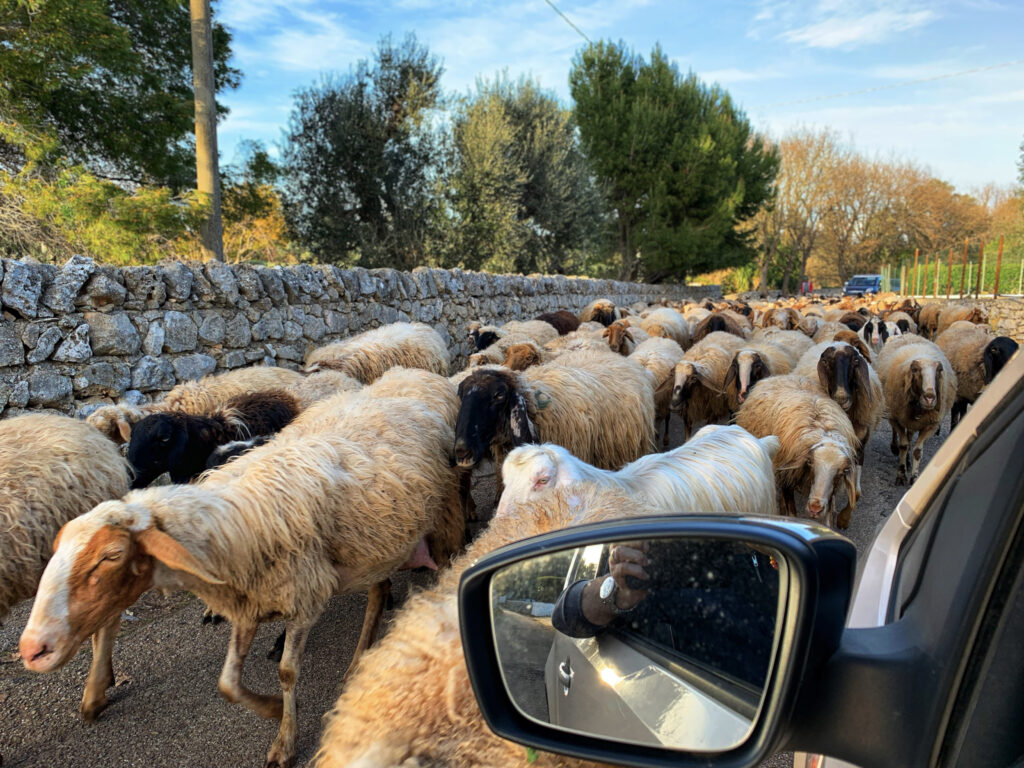
Driving in Italy | legal requirements
To drive in Italy you must be at least 18 years of age and hold a valid driving licence. The necessary documents vary, depending on the type of vehicle.
For a car from an EU country:
- Registration certificate
- Driving licence
- Insurance policy.
For a car from a non-EU country:
- Registration certificate
- Driving licence issued by a foreign non-EU country
- International driving licence or sworn translation of the licence
- Green card or temporary border insurance policy, (check with your insurance company)
- Sticker with the initials of the country you are travelling from.
For a motorbike:
The same documents are required for travelling by motorbike. Additionally, it is mandatory to wear a UE approved helmet.
If the motorbike has an Italian number plate, you must show your vehicle tax payment sticker.
For camper vans:
- Driving licence from an EU country
- If non-EU, international driving licence or a sworn translation of the licence
- Insurance – civil liability against third parties
- Vehicle registration card if EU; for non-EU, check whether you need a green card or temporary border insurance policy, and affix a sticker with the country’s initials.
Requirements for renting a vehicle in Italy
For renting a car in Italy you will need:
- Driving licence from an EU country, held for at least one year
- If non-EU, international driving permit or a sworn translation of the licence
- Identity document
- Credit card in the driver’s name.
Many companies require drivers to be at least 21 or 23 years of age to rent a car in Italy, with a maximum age limit of between 65 and 75. It is almost always necessary to have had a driving licence for at least one year. Check with the insurance company in advance of travel.
Puglia’s highway infrastructure
Puglia boasts a diverse and well-connected highway and public road infrastructure. The region is served by several major highways, as well as a network of regional and provincial roads.
The main highway in Puglia is the SS16, which runs along the Adriatic coast and connects major cities such as Bari, Brindisi, Lecce, and Otranto. This highway offers convenient access to coastal towns and popular tourist destinations.
The SS16 branches off twice from the coastal highway, which continues as the SS379 between Monopoli and Brindisi and as the SS613 between Brindisi to Lecce. The SS16 connects once again running through the centre of Lecce before joining the Lecce ring road (the SS694 tangenziale ovest (west) and tangenziale est (east)) onward to Otranto.
Puglia’s highway system also includes the SS7 and SS603, which connects Brindisi to Taranto, the SS101, which runs from Lecce to Gallipoli, then continuing south towards Santa Maria di Leuca as the SS274. Travelling south from Lecce to Leuca will take you from the SS16 onto the SS275 (the SS16 continues to Otranto).
These highways provide efficient transportation links within the region.
In terms of public roads, Puglia has a comprehensive network of strade statali (state roads), strade regionali (regional roads), and strade provinciale (provincial roads). The strade statali, designated with the prefix “SS,” are major roads that connect various cities and towns in the region. They generally offer well-maintained routes and connect to the highway system. Usually they are dual carriageway (where the SS16 branches off from the Adriatic highway it no longer is).
The strade regionali, marked with the prefix “SR,” are regional roads that primarily serve transportation needs within specific regions of Puglia. These roads are often scenic and provide access to smaller towns and countryside areas. Usually they are one lane highway on either side which means getting stuck behind slower moving agricultural traffic is more likely!
The strade provinciale, identified with the prefix “SP,” are provincial roads maintained by local authorities. These roads mainly serve local traffic, connecting towns and villages within a specific province.
In terms of infrastructure quality, Puglia’s highways generally offer good conditions, with well-paved surfaces and appropriate signage. The regional and provincial roads may vary in quality, with some smaller roads in rural areas potentially experiencing less frequent maintenance.
It’s important to note that Puglia, like other regions in Italy, has its fair share of traffic congestion, particularly during peak travel times and in urban areas. Drivers should be prepared for potential delays and exercise caution while navigating through heavy traffic.
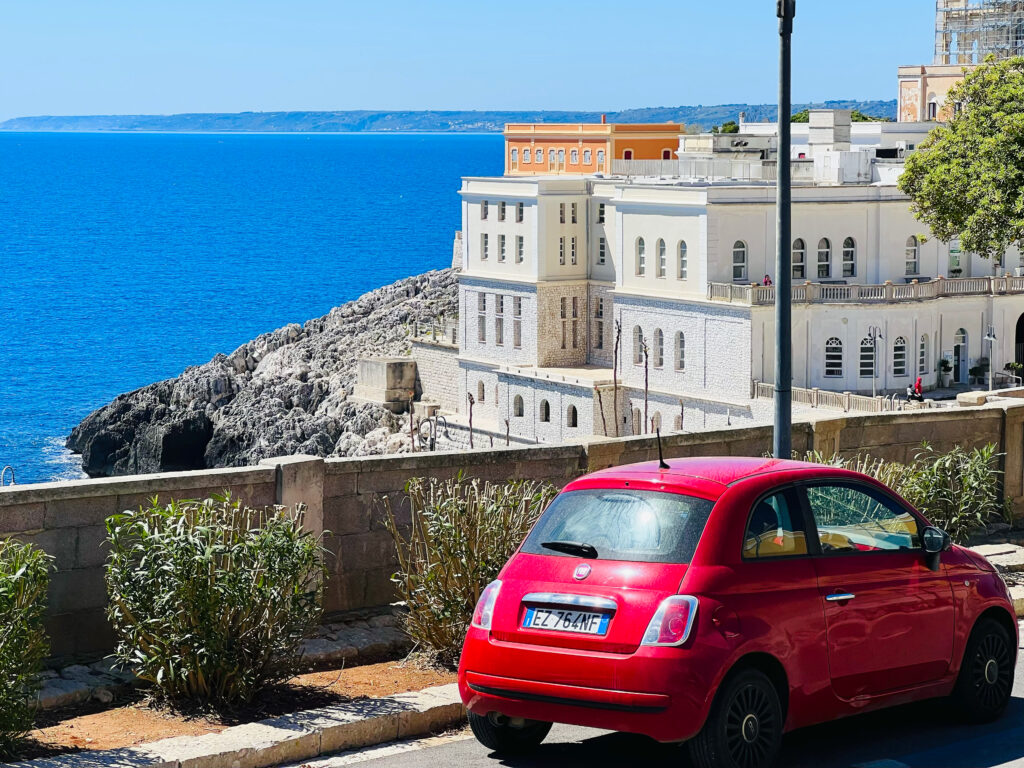
On the road | the driving experience
Italian drivers are known for their aggressive driving style and speed on the road. In our experience they are generally competent drivers*, albeit selfish and inconsiderate to other road users. Don’t be intimidated. Stay confident and you’ll blend in seamlessly with the local traffic flow.
While there is a highway code called the Codice della Strada in Italy, a more “relaxed” approach is often taken, particularly in smaller towns. It is not uncommon to encounter drivers who overlook certain rules and adopt their own driving habits.
Texting and driving is not uncommon. Stop at a red light, take a glance around—chances are, most drivers nearby are scrolling through their phones. Rather than close their phone and drive on, they will continue to interact with it while driving. In 2023, a survey for Italian insurance websites found that a staggering 34% of drivers aged 35-44 confessed to using their phones while driving.
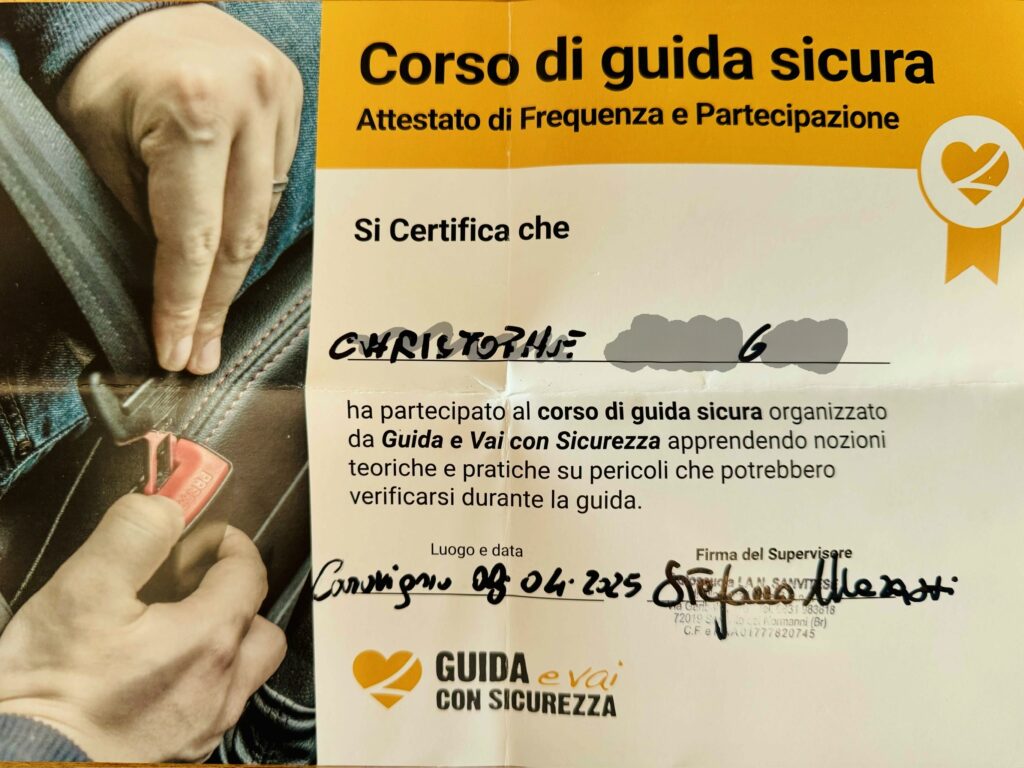
Indicators | turn signals
One particular habit that stands out is the limited use of indicators, or turn signals. In Italy, the physical act of turning, changing lanes, or overtaking is often seen as sufficient indication of the driver’s intentions, making the use of indicators redundant. Many Italian drivers do not use their indicators whether on the highway, at junctions, or on roundabouts. If nothing else, using indicators is an act of courtesy to other drivers, and the fact that it’s a rare sight in Italy speaks volumes.
Roundabouts | traffic circles
Roundabouts can sometimes feel like a free-for-all. It is essential to approach them with caution, especially the smaller ones outside larger cities. Some Italian drivers learned to drive before roundabouts were commonplace in Italy, while others may have forgotten the rules or simply disregard them.
On Italian roads the default priority rule is to give way to traffic approaching from the right UNLESS there are road signs or markings indicating the contrary. But as with many rules and instructions independently-minded Italians take little notice.
According to the Italian Highway Code, roundabouts are considered intersections, and priority signs or road markings dictate the right of way. If there are no signs or markings, priority is given to traffic on the right, that is to vehicles coming onto the roundabout.
Most roundabouts in Italy follow the “European” style, where signs and road markings give priority to vehicles already on the roundabout.
Some older “Italian” roundabouts still exist, without any accompanying priority signs, which require traffic on the roundabout to yield to vehicles entering. In other words, the traditional priority rule of giving way to traffic on the right applies.
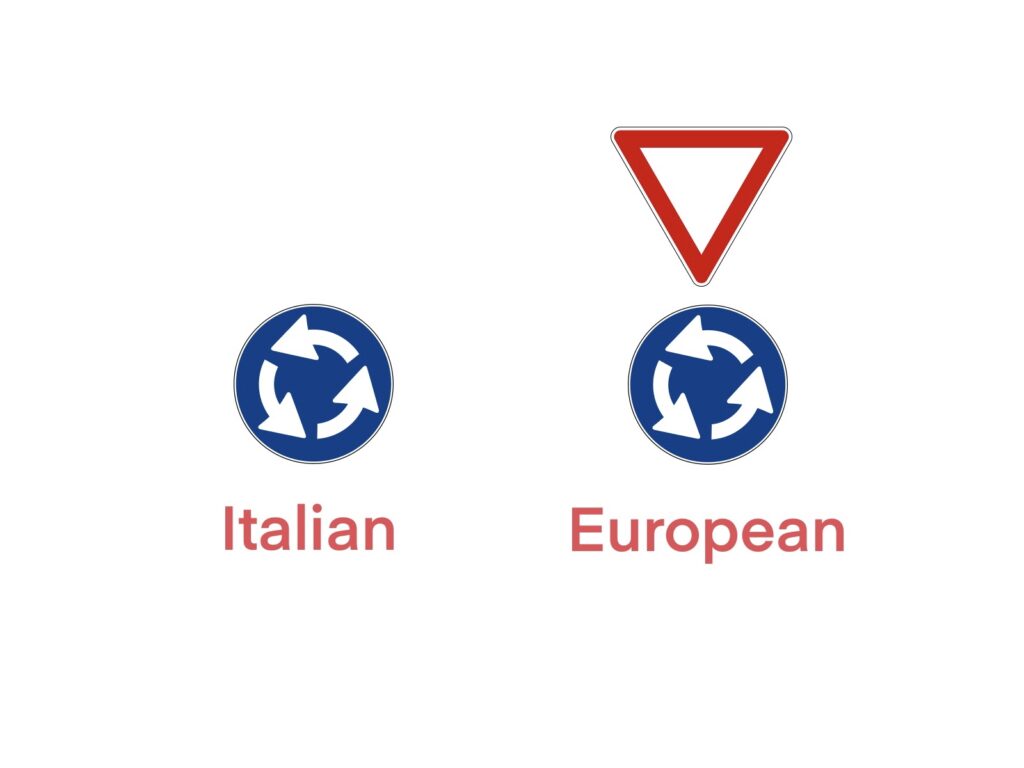
It is important to be aware of this distinction and ALWAYS be prepared for Italian drivers, especially older ones, who may assume they have priority when entering a roundabout without slowing down or glancing left.
When on a roundabout you might also experience drivers in front of you stopping to give way to approaching vehicles ahead of them, letting them enter the roundabout.
Since 2011, indicating entry and exit from roundabouts has been mandatory in Italy. It is considered good practice to indicate when going around the roundabout and exiting to the left. Not that you would know!
In cities like Lecce, the series of roundabouts along the main highway (SS613) from the north, particularly the first two near the bus station and just before the old town, can be chaotic during peak morning and afternoon/evening hours. It may require some courage and conviction to navigate these roundabouts, but don’t let the impatience of others behind you stress you out. Drivers in Ostuni generally manage roundabouts better, except for the busy SS16/via Papa Giovanni XXIII/SP22 roundabout.
Despite the occasional chaos, it is worth noting that accidents on roundabouts in Puglia are relatively rare.
Lastly, it is quite common to find Italian drivers using roundabouts as a convenient parking.
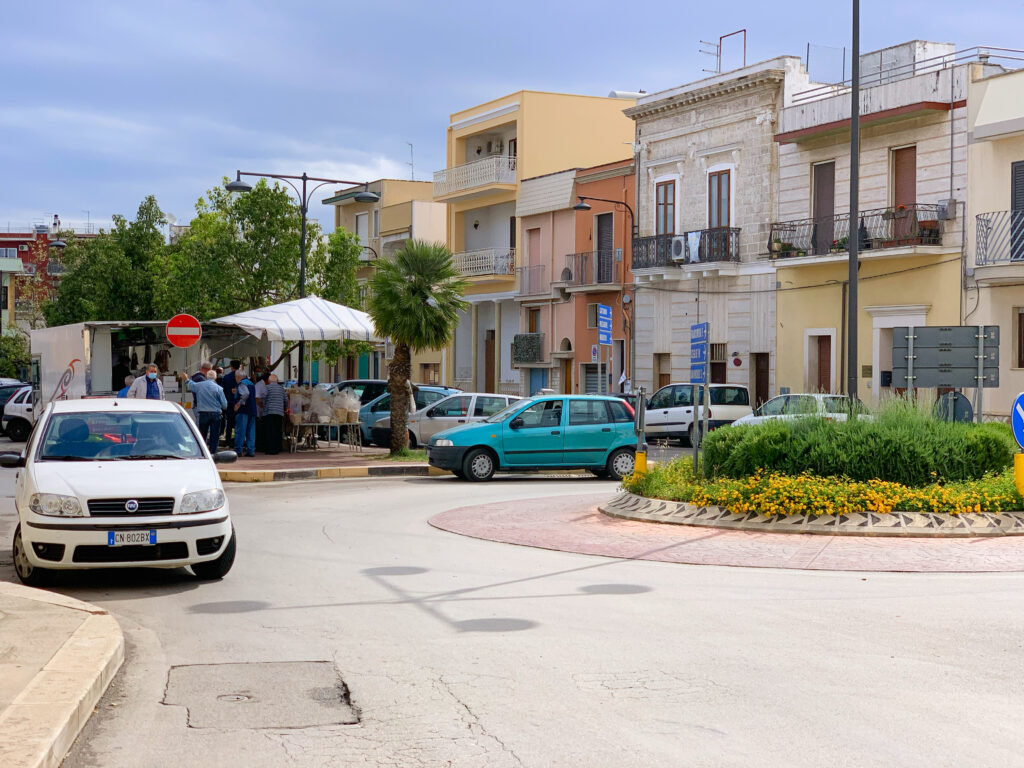
A matter of priority
Understanding right-of-way is crucial at junctions. Vehicles must yield to those approaching from the right unless there are signs indicating a different priority.
A stop sign means you must give way to traffic approaching from both sides.
Take caution as faded road markings can make priority rules unclear. Some towns implement one-way systems, granting priority to left-side traffic.
But once again be prepared for Italian drivers to ignore the rules of the road!
Junctions also serve as impromptu social hubs for Italian drivers. Don’t be surprised if motorists stop in the middle of the road to chat, drop off passengers, or buy cigarettes and bread, regardless of traffic behind them. It is just another unique aspect of driving in southern Italian towns.
Give yourself bonus points when the driver in front of you and the car coming in the opposite direction both stop to chat to each other.
Tailgating and highway tips
When driving in Puglia, be prepared for Italian drivers to tailgate closely when they want to overtake. On motorways and dual carriageways, tailgating is practically a national sport. Speeding cars will suddenly appear right up behind you, headlights flashing, demanding an immediate right of way and following closely until an opportunity to pass arises.
Instead of waiting for a safe passing moment, Italian drivers often cut in front of vehicles in the overtaking lane without signaling, expecting or forcing them to slow down. They will then abruptly merge back into the lane they overtook. This pattern continues, creating a somewhat unpredictable driving experience.
If you’re flashed at night while being overtaken, don’t worry. Many drivers do this to alert you to their presence; it is not because your rear lights aren’t functioning properly (something else that doesn’t seem to concern drivers in the south).
During the day, if oncoming traffic flashes their lights, it is often to notify you of police presence further down the road, such as a mobile speed camera or a random police checkpoint to check documents.
The ZTL (Restricted Traffic Zone)
Historic old town centers in Puglia were not designed for vehicles, which becomes evident if you inadvertently find yourself driving into one. Driving within old towns can be impractical and challenging, and it is advisable to explore them on foot instead.
Most old towns have a Zona Traffico Limitato (ZTL), which prohibits private vehicles from entering, except during specific hours usually in the early morning and late afternoon.
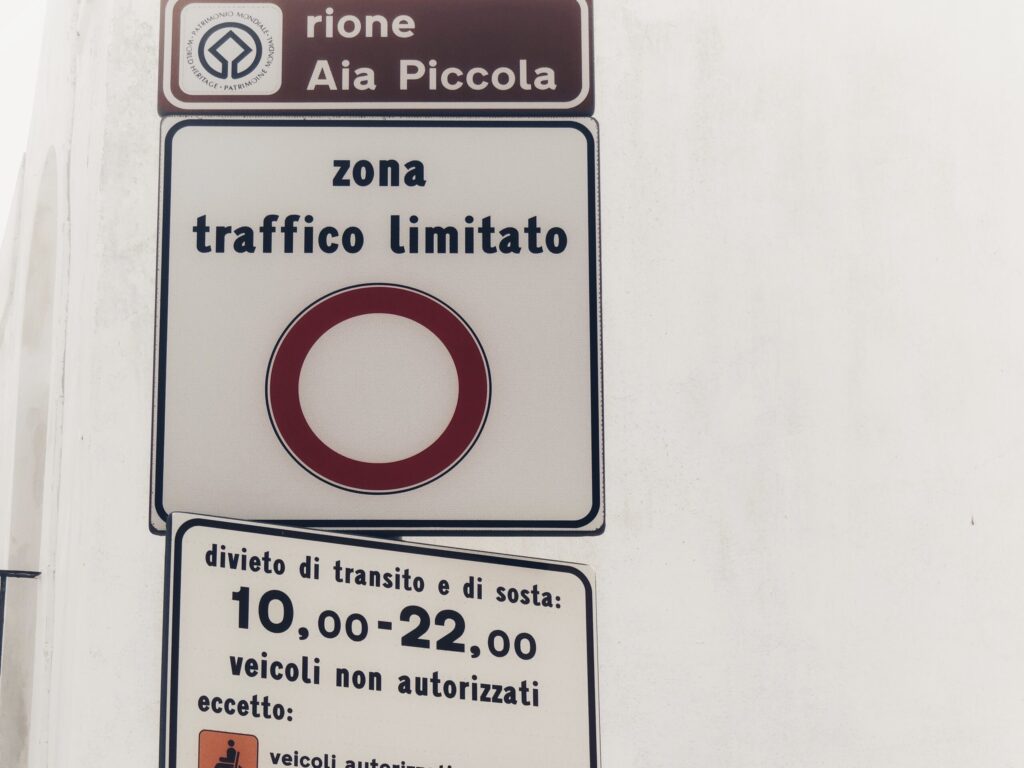
Look for a sign depicting a white circle with red borders, indicating the restricted hours. Navigating an unfamiliar area while keeping an eye on the road, following SatNav instructions, and dealing with impatient Italian drivers behind you can make it easy to miss these signs.
Enter or exit a ZTL, and cameras will capture your license plate. The photo is automatically sent to the Municipal Police computer. A fine will be issued and forwarded by the car hire company.
Even a simple mistake of entering a ZTL can result in receiving a fine from the car rental company months after your return, ranging from €81 to €326, with an average of €180 in Puglia. These fines are often enforced against foreign drivers.
Driving in Puglia | Parking
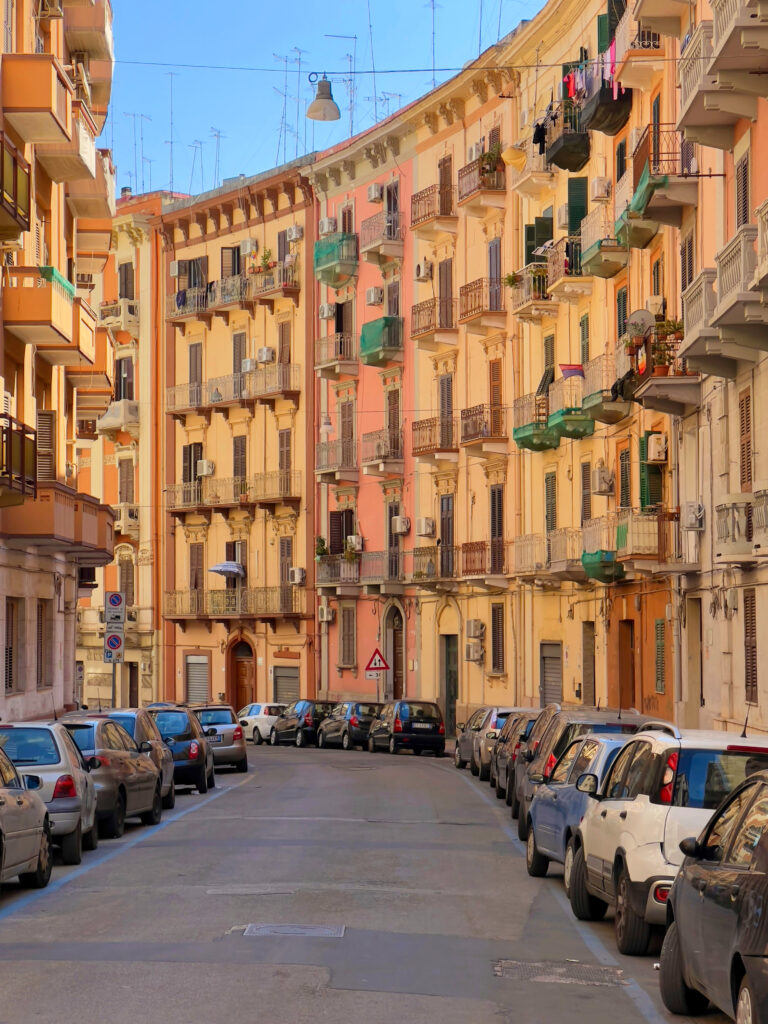
Parking in Puglia can be a challenge, especially finding a suitable space and maneuvering into it.
Italians have perfected creative parking techniques. Parallel parking skills aren’t necessary when one can simply nose into a space, regardless of the car’s fit. Tail sticking out? No problem. Corner spots at junctions, pedestrian crossings, and roundabouts are fair game for resourceful Italian drivers.
Choosing a smaller rental car proves advantageous when it comes to parking.
Blue lines
On-street parking in towns and cities is usually marked on the road surface. Blue lines indicate “pay and display” parking. Check accompanying signs for details. Payment can be made with coins, many machines accept cards, and some can be paid for using parking apps. Some tobacconists sell coupons for parking by the hour.
Check the information on signs and pay stations to find out the times and days when pay parking applies (often there are “free” hours when no payment is required) as well as the hourly cost of parking. Keep an eye on the ticket expiration time as you are feeding in your coins. Machines account for free parking hours.
You may need to input your car’s registration (license plate) number before purchasing a ticket. Look for the instruction “Digitare la targa del proprio veicolo.” Keeping a photo of your car’s registration number on your smartphone saves time (some hire car keys will have the registration number already attached). If you’ve already queued at the meter, you won’t have to join the line again.
Some parking ticket machines (in Bari for example) require you to enter only the numeric elements of the registration. Thus FB369IT would only need you to enter ‘369’.
Ensure your ticket is clearly displayed on the dashboard inside the car. The same rules apply to municipal car parks.
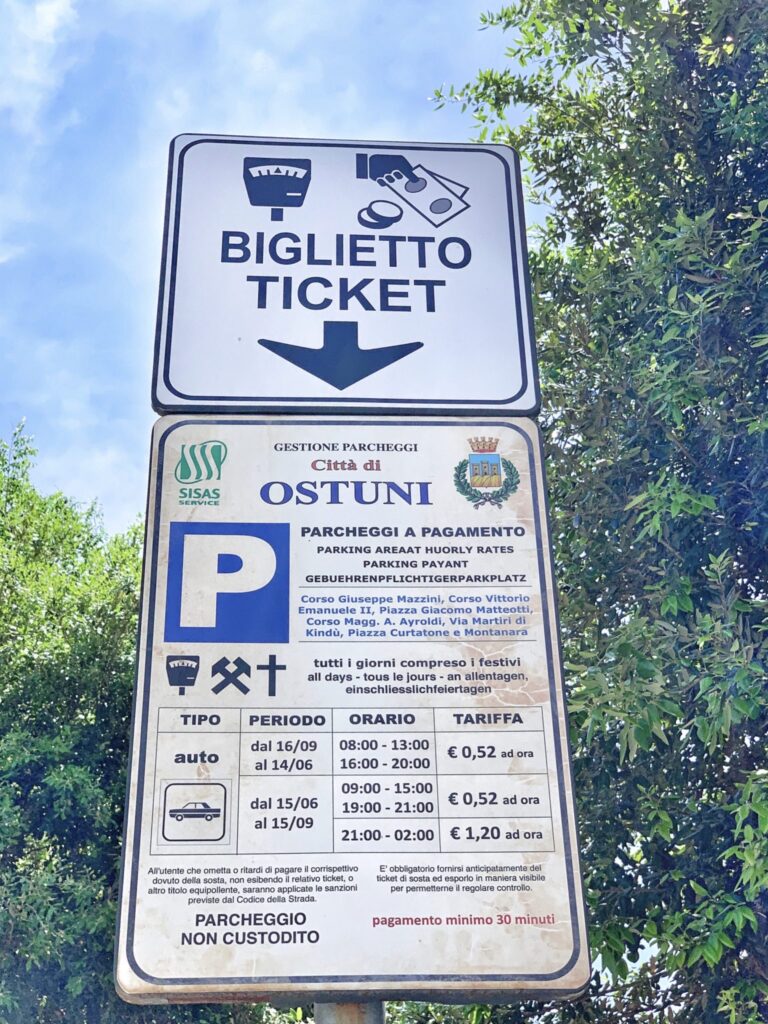
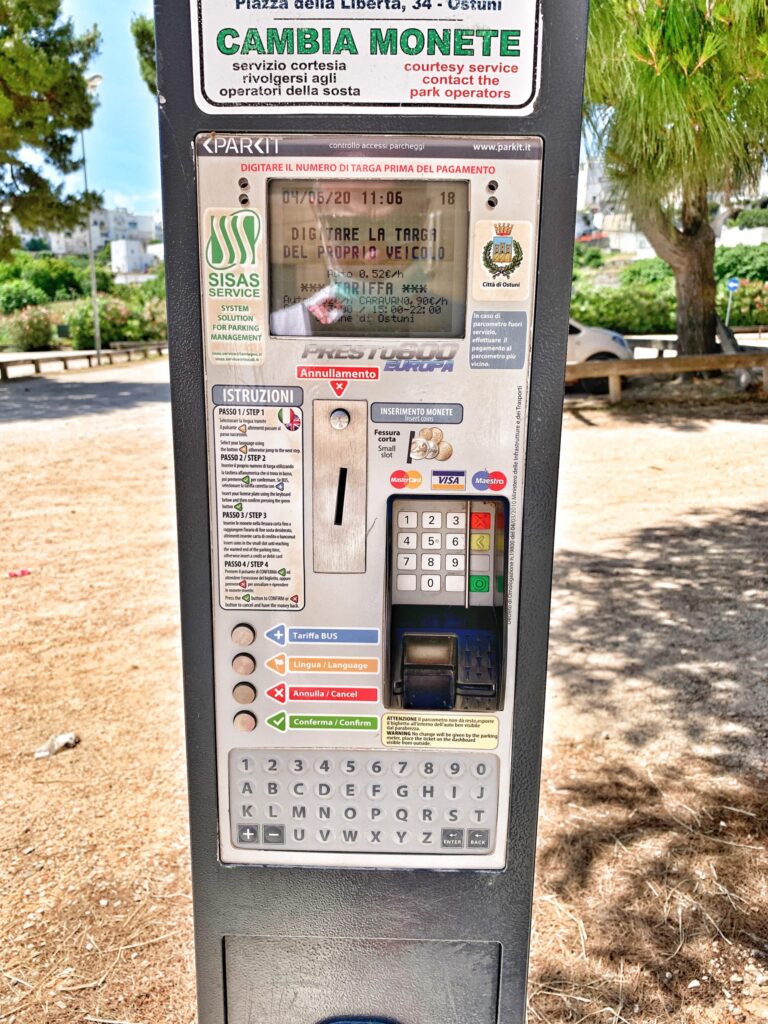
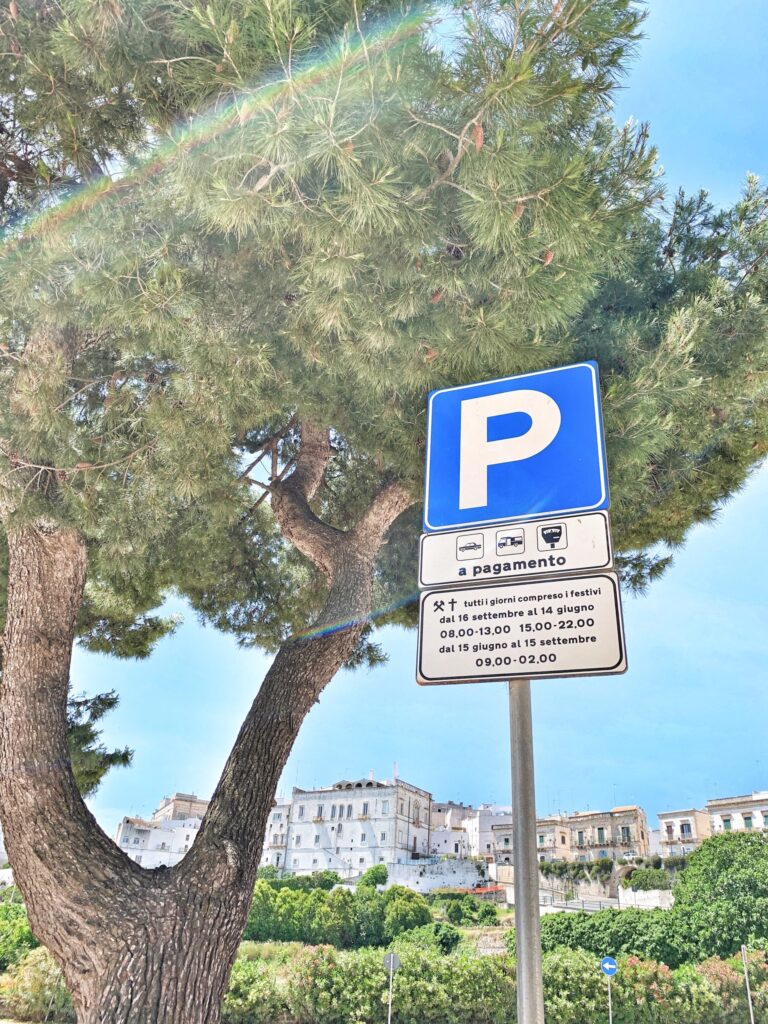
White lines mean that parking is free, but pay attention for any adjacent signs indicating restrictions, such as maximum time limits. In these cases, display a parking disc on your dashboard indicating the arrival time. You can purchase these discs for a few euros at tobacconists or newspaper shops. Rental cars often come with these discs already attached to the windshield.
Yellow lines indicate that spaces are reserved for disabled badges, taxis, or official vehicles. You may encounter green zones with restricted parking during certain hours on working days for deliveries and similar activities. A number of pink spaces are for pregnant women or those with young children (check adjacent signs).
Do not park in areas reserved for the disabled. These parking spaces are well marked with yellow lines and often have special signs. They are free of charge for those entitled to park and their carers, who can also park free of charge on the blue lines.
Parcheggiatore abusivo | Parking Scams
If you’ve ever parked your hire car on a quiet side street in southern Italy and been approached by a man waving vaguely at the kerb or gesturing to a nearby space, you may have just met a parcheggiatore abusivo—an unofficial, self-appointed car park “guardian” who expects a small fee to “look after” your vehicle.
While tales of the parcheggiatore abusivo—the unofficial parking “guard”—can seem unsettling to the uninitiated, in practice we’ve encountered it only infrequently during our travels around Puglia.
A recent example of it happening (April 2025) in Taranto along Lungomare Vittorio Emmanuele III was reported to us by a someone who had been following our guides.
In many cases, if there’s ample parking nearby, we simply move on. But in busier towns or near popular beaches where space is scarce, offering €1–2 can be a small price to pay for peace of mind. It’s important to remember that these men—and they are almost always men—are usually acting out of economic necessity rather than malice. In areas with high unemployment, limited opportunities, and little social safety net, this informal practice has become a tolerated form of street-level income.
For some, it may feel like a relic of protection rackets; for others, it’s just a quiet transaction that avoids unnecessary hassle.
More detailed analysis and insight is covered in our feature about The Unofficial Guardians of the Kerb: Parking Scams Tourists Should Know About.
Driving in Puglia | Fuelling Up
Most petrol stations offer self-service, but you can opt for attendant service at a slightly higher cost (around €0.08 more per liter).
For self-service, you typically need to pay in advance and select the pump. Make sure you have cash notes as VISA debit/credit cards often don’t work well. Even Italian bank and credit cards can sometimes be challenging!
No change is given, so if you select €50 of fuel and your tank fills up after €30, the driver behind you will be pleased. Keep some twenties and tens on hand, as you can always add another €20 of fuel afterward.
Some stations on the autostrada and main highways allow you to fill up and pay afterward, where cards tend to work better. However, these stations are less common.
Be careful to choose the correct pump, it is an easy mistake to select the pump on the opposite side and have to stretch the hose across.
“Benzina” = petrol, unleaded = “senza Pb”.
Visitors from the US please note: feedback we have had from three sets of American visitors this April 2025 is that many vendors, restaurants, gas stations and others do not accept AmEx (American Express) cards because the commission costs for using them as a merchandiser are too expensive. Be sure to have other non AmEx cards for use if you plan to pay by credit card.
Speed Limits
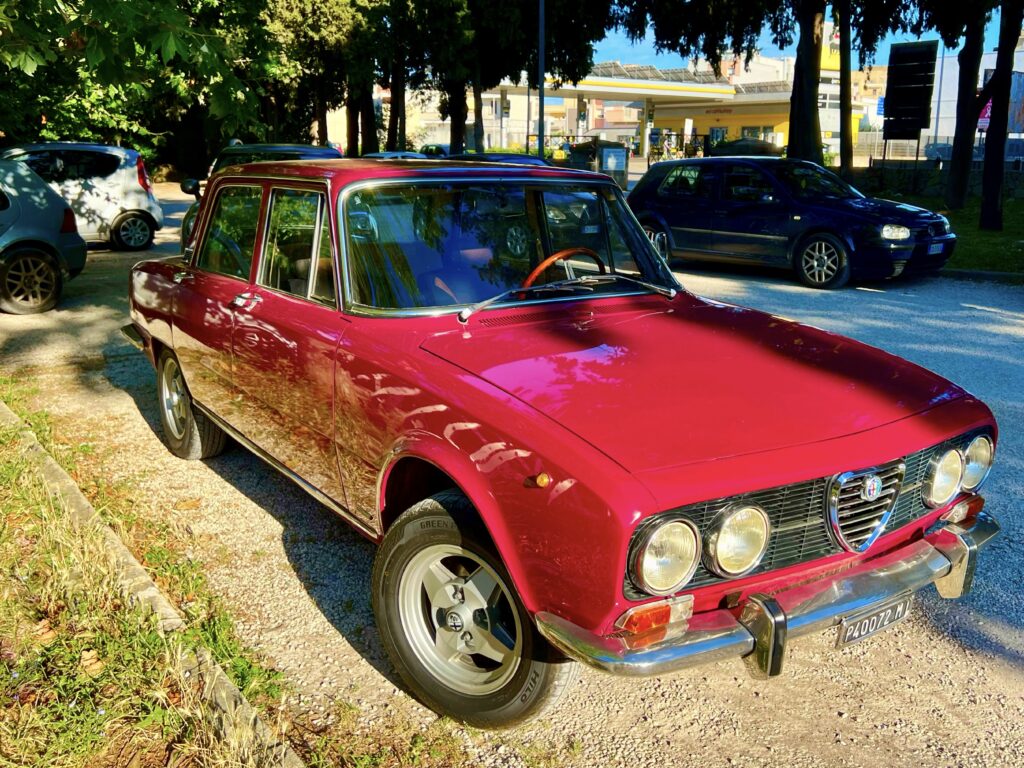
Maximum speed limits apply as follows (subject to any contrary road signs):
- 50 km/h in built-up areas in built-up areas (urban areas). Beware that these limits often extend to the stretch of highway passing around the towns, so watch for signs indicating lowered speed limits, even on highways.
- 90 km/h on secondary and local roads, 110 km/h on main roads (non-major highways outside major urban areas), and 130 km/h on motorways.
On the Adriatic highway (subject to any contra-indication signage) the speed is limited to 90 km/h for most of the Bari – Ostuni section, increasing to 110 km/h just before Ostuni. On the toll roads the limit is 130 km/h.
Speed limits for newly-qualified drivers: Special speed limits on motorways (100 km/h) and on main roads (90 km/h) for those who have held their licence for less than three years. Speed limits are the same for urban roads and secondary or local roads.
For camper vans, the limits are: 50 km/h in built-up areas, 80 km/h outside of built-up areas, 100 km/h on motorways (if over 3.5 t and up to 12 t total laden mass), 50 km/h in built-up areas, 70 km/h outside of built-up areas, 80 km/h on motorways (if over 12 t total laden mass).
For motorbikes and mini-cars up to 50 cc the maximum speed is 45 km/h. They are not allowed to drive on motorways, although this is possible for more powerful motorcycles.
Sidelights
Sidelights and dipped beams should be kept on outside of built-up areas. Dipped beams should be used from half an hour after sunset to half an hour before sunrise or in the event of poor visibility.
Motorcyclists must also keep their sidelights and dipped beams on in built-up areas.
Dipped beams are required in tunnels.
Driving in Puglia | Highway vs. Local Routes
Driving through Puglia’s countryside is breathtaking, particularly in areas like Valle d’Itria or our personal favorite, the coastal road from Santa Cesarea Terme to Santa Maria di Leuca.
Once you venture into the countryside, you’ll encounter many single-lane roads, even on main routes. Some roads are narrow and can accommodate only one vehicle at a time.
Expect slow-moving agricultural vehicles as soon as you leave the highway. Getting stuck behind a tractor or “ape” (a three-wheeled utility vehicle) can be frustrating, especially when there’s already a long line of traffic behind them on a winding road filled with curves and bends.
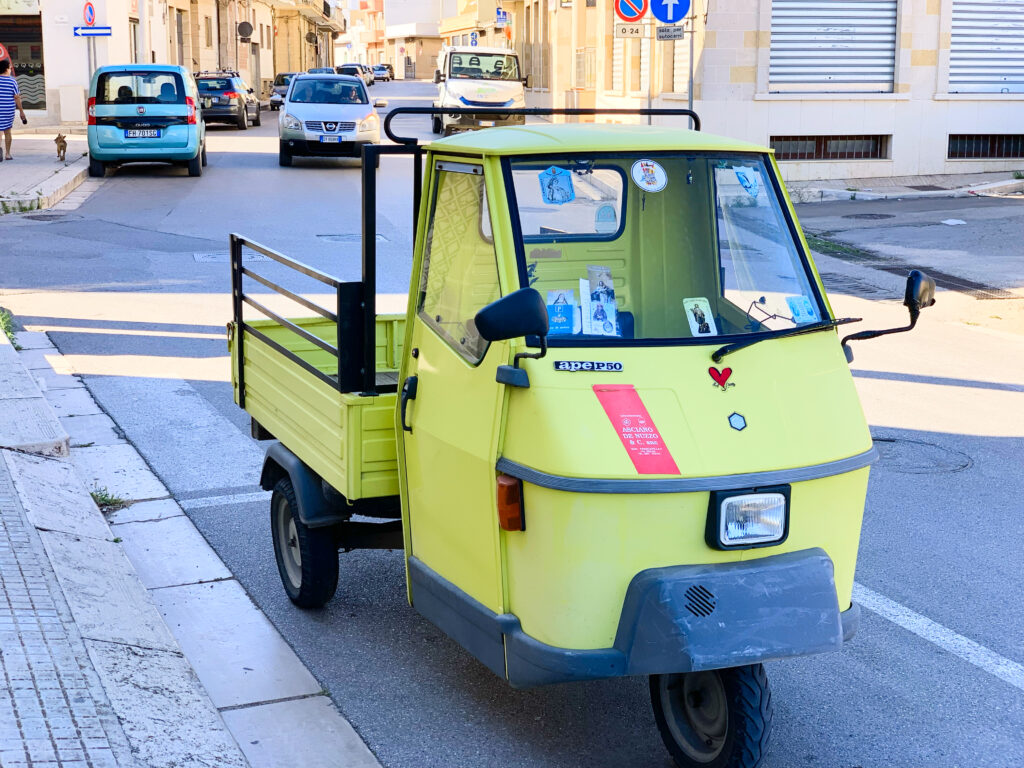
Italy’s road classification system includes:
- Strade comunali (municipal roads)
- Strade provinciali (provincial roads)
- Strade regionali (regional roads)
- Strade statali (state roads)
- Autostrade (highways)
The traffic volume on strade statali (SS) varies from place to place. Some are busy roads, but they can also be quiet and scenic, particularly in remote parts of Puglia.
The SS16 is the main highway around Bari but diverts from the highway to Fasano, Ostuni, and San Vito dei Normanni before rejoining the highway at Brindisi.
There are also instances where a new, faster road (superstrada or strada scorrevole) has been built alongside certain strade statali, leaving the old road with the same classification. (Strade regionali, by the way, are essentially strade statali where maintenance responsibility has been transferred to the regional government.)
This situation occurs with the SS16 as well. It separates from the highway heading south around Brindisi, where the highway becomes the SS379 and the SS16 runs parallel to the west of the highway.
For local routes, strade provinciali (SP) and strade comunale are usually a reliable choice. However, keep in mind that a strada provinciale between two towns may still have significant local traffic.
Driving in Puglia | The SS16 Bari “tangenziale”
The ring road around Bari is designated as the SS16 ring road (tangenziale). It features freeway-like characteristics, with separate lanes expanding from two to three around junction 4 before reducing back to two near junction 14. You will navigate it driving south from Bari airport, or heading north to Bari airport.
As the Bari tangenziale is the busiest stretch of road in Puglia, it might feel like a baptism of fire, but fear not! Things can only get better.
There are two challenging sections to watch out for that demand extra attention. The initial stretch of highway after leaving Bari airport heading south, curving around Palese, is a busy section with a minimal or non-existent shoulder. Acoustic screens are erected. It feels narrower as a result.
Apart from that, the road is generally unproblematic. Traffic usually flows freely, except during peak times around Bari. Traffic is noticeably busier over the summer months building up from July to its busiest around the ferragosto holiday (15 August) and the last weekend in August.
In the south because of la pausa (the year round afternoon siesta) which means a split working day, we have a morning rush hour (from 8am – 9.30 am), a lunch time rush hour, a mid-afternoon rush hour (around 4pm – 5pm) and an evening rush hour (from 7.30pm)!
There is also heavier traffic entering/exiting and around Lecce, and to a lesser extent, around Brindisi, which may cause congestion during peak hours.
Driving in Puglia | The Lecce “tangenziale”
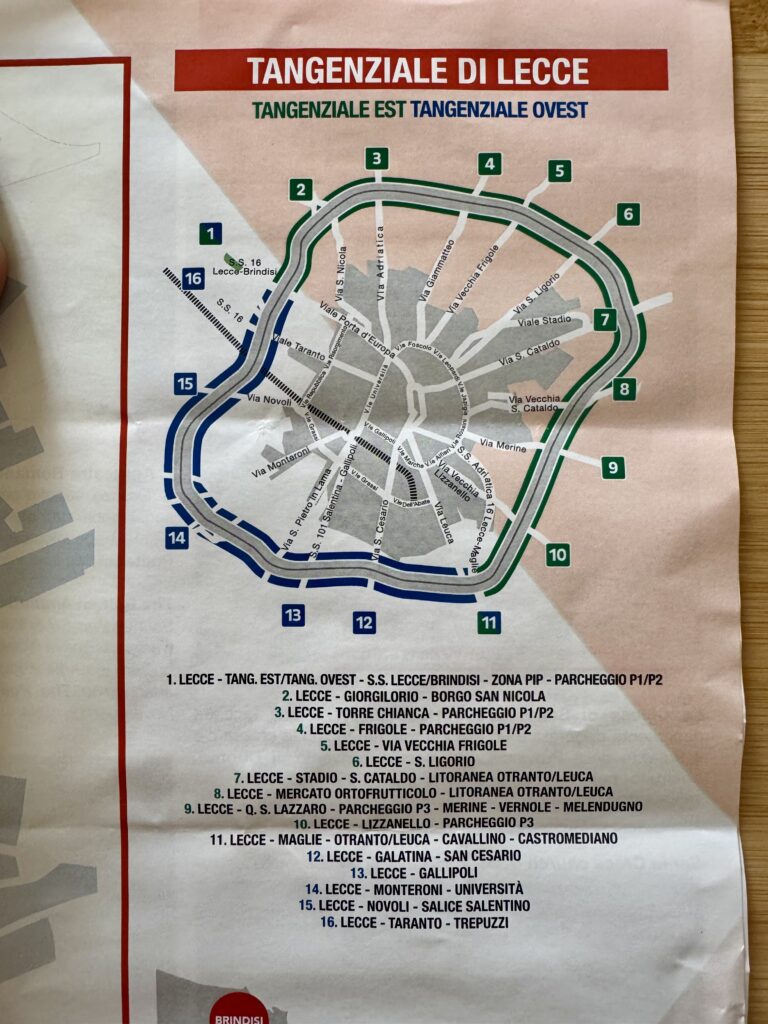
The Lecce tangenziale is one continuous ring road, split into east and west for ease of navigation.
Some tips: when Driving south from the Brindisi-Lecce Adriatic highway (the SS16) to Otranto, Leuca etc. the road signs will direct you to the 2nd exit signed for Maglie, Otranto and Leuca, that is along the east section of the tangenziale (shown green above, via exits 1-11).
But if you take the first exit before it for Gallipoli/Galatina, along the west (ovest) section (shown blue, via exits 16-11), it is around 15 minutes quicker.
Coming back from the south of Lecce, it’s a similar story. The first exit for Brindisi is an exit for the tangenziale est. Immediately after is the exit for Gallipoli to exit onto the tangenziale ovest – which will take you to the Brindisi exit (exit 1) more quickly.
Coming back from Gallipoli heading towards Brindisi, once you are on the tangenziale (ramp 13A), stay on it all the way to exit 1. As you approach the hospital (“Ospedale”) at exit 13B you will see an overhead sign indicating Brindisi straight on, but at the same exit you might notice a confusing small road sign on the right indicating a turn off for Brindisi. A little further on there is another small Brindisi turn off sign. Ignore them. Otherwise they will set you all the way anticlockwise around Lecce, taking twice as long. To get to Brindisi you stay on the tangenziale all the way around the Ospedale, and through the tunnels, continuing on a little further for the Brindisi exit.
Driving in Puglia | Toll Roads
Toll booths are located at the entrances of the autostrade (highways). Autostrade are identified by the letter A followed by a number, such as A1, and a green octagonal sign.
Upon entering the toll road, a ticket is issued by an automated machine. Unless you have a Telepass, do not use the TELEPASS lane.
Keep the ticket you receive as you will need it to exit the toll road. At the exit, you pay the toll at the toll booths. If you fail to present the ticket at the exit, you will be charged the maximum toll fee. When approaching the toll road exit, ensure you are in the correct lane based on your chosen method of payment.
The white lane with the coins symbol is for self-service cash payment.
The blue lane with the cards symbol is for payment using credit cards, ATMs, or bancomat cards.
The yellow TELEPASS lane is reserved for vehicles equipped with an electronic scanner that automatically calculates the toll and debits the user’s account.
The toll you pay is calculated based on factors such as distance, vehicle type, and road characteristics (e.g., plain or mountainous). You can use an online tool to calculate your journey’s toll fees.
Trunk (SS), regional (SR), and provincial (SP) roads do not require any toll payment. They are indicated by a blue rectangular sign.
If you are using GPS or a SatNav device, note that your settings might default to exclude pay/toll roads, which could explain why the estimated journey time appears to be two or three times longer than expected. Double-check your settings to ensure toll roads are included if you intend to use them.
In the event of an accident
Don’t panic. Put on your reflective jacket or vest and call the local police. To request ACI roadside assistance, the toll-free number is 800 116 800, available all year round 24 hours a day (8803 116 toll-free from a landline or mobile with Italian provider).
On motorways S.O.S. posts are provided to call for roadside assistance from the first available road patrol.
The hearing impaired can obtain Road Assistance in Italy by sending an SMS to the mobile phone number +39 339 994 3116. Information on road and traffic conditions is available 24 hours a day through the telephone
number 1518 (in Italian only).
If you have a hire car you should contact your car hire company on the number they will have provided you with.
What to do in the event of a road accident with casualties
In this situation, calling for assistance is a priority. If you cause or witness an accident in which people or animals are injured, the driver is obliged to stop and provide assistance. The Single Emergency Number 112 (NUE 112) is the telephone number for calling the emergency services in all EU countries. There are 16 languages available. However, in Italy this number is not yet active in all regions and provinces. Therefore, the usual numbers may still be valid: 118 to request an ambulance; 112 for the Carabinieri (national gendarmerie of Italy); 113 Police or Traffic Police; 115 Fire Brigade.
To find out more, you can visit the Driving in Italy section on the Automobile Club d’Italia website.
Car essentials
- Warning triangle, which must be positioned at least 50 metres from the rear of the car in the event of an emergency stop.
- Reflective jacket or high-visibility braces to be worn in the event of an accident or breakdown outside of built-up areas.
- Seat belts for the driver and passengers. When travelling with children under 1.50 metres tall, additional caution is required: they must sit in approved child seats.
- Motorbike drivers under the age of 16 cannot carry a passenger. Persons over 16 are permitted to carry a child over the age of 5. Helmets are compulsory for drivers and any passenger.
Wear prescription glasses if required and sunglasses when necessary, and appropriate foot wear.
The use of mobile phones and electronic devices is prohibited, as is driving under the influence of drugs and/or psychotropic substances.
Alcohol limit in Italy
We do not drink when we drive. There are no “safe” levels of alcohol consumption when driving.
The alcohol driving limit in Italy is 0.5 grams per litre for all vehicles, including motorbikes. For new drivers (i.e. in the first three years after obtaining a licence) and professional drivers there is an absolute zero tolerance.
In the event of drink-driving, penalties include fines and/or the suspension or revocation of the driving licence, depending on the blood alcohol level detected. The law identifies three thresholds:
- Blood Alcohol level up to 0.5 grams of alcohol per litre of blood
- Blood alcohol level above 0.5 g/l but not exceeding 0.8 g/l
- Blood alcohol level of more than 0.8 g/l but not more than 1.5 g/l
- Blood alcohol level exceeding 1.5 g/l.
The latter two constitute a criminal offence that can include a detention by the court (the former attract administrative fines).
Driving in Puglia | the Puglia Guys car hire guide
Hiring a car in Puglia is one of the best ways to explore its scenic countryside, historic towns, and off the beaten track beaches that you can’t get to by public transport. Navigating the car hire process needs a little planning. Our Puglia car hire guide will help to ensure a smooth experience and get the best value for your money.
* A 2022 survey by France’s Vinci Autoroutes found that only 16% of Italians considered their compatriots to be ‘civil’ on the road. In an equally grim 2015 survey by the same organisation 45% of Italians described their fellow drivers as irresponsible, 37% as stressed, 26% as aggressive, and 34% as downright dangerous.
IMPORTANT DISCLAIMER | Every care has been taken to accurately represent the legal requirements for driving in Italy as also the law and rules of the road at the time of writing. However these may have changed since the original publication so you should not rely on the information contained in this post, which is indicative only. It is your responsibility to ascertain what these are at the date of your travel and to ensure compliance with Italian law and driving requirements as they apply at the date of your travel.
More
Getting to Puglia and getting around Puglia.
Navigating Puglia | A guide to public transport in Puglia.

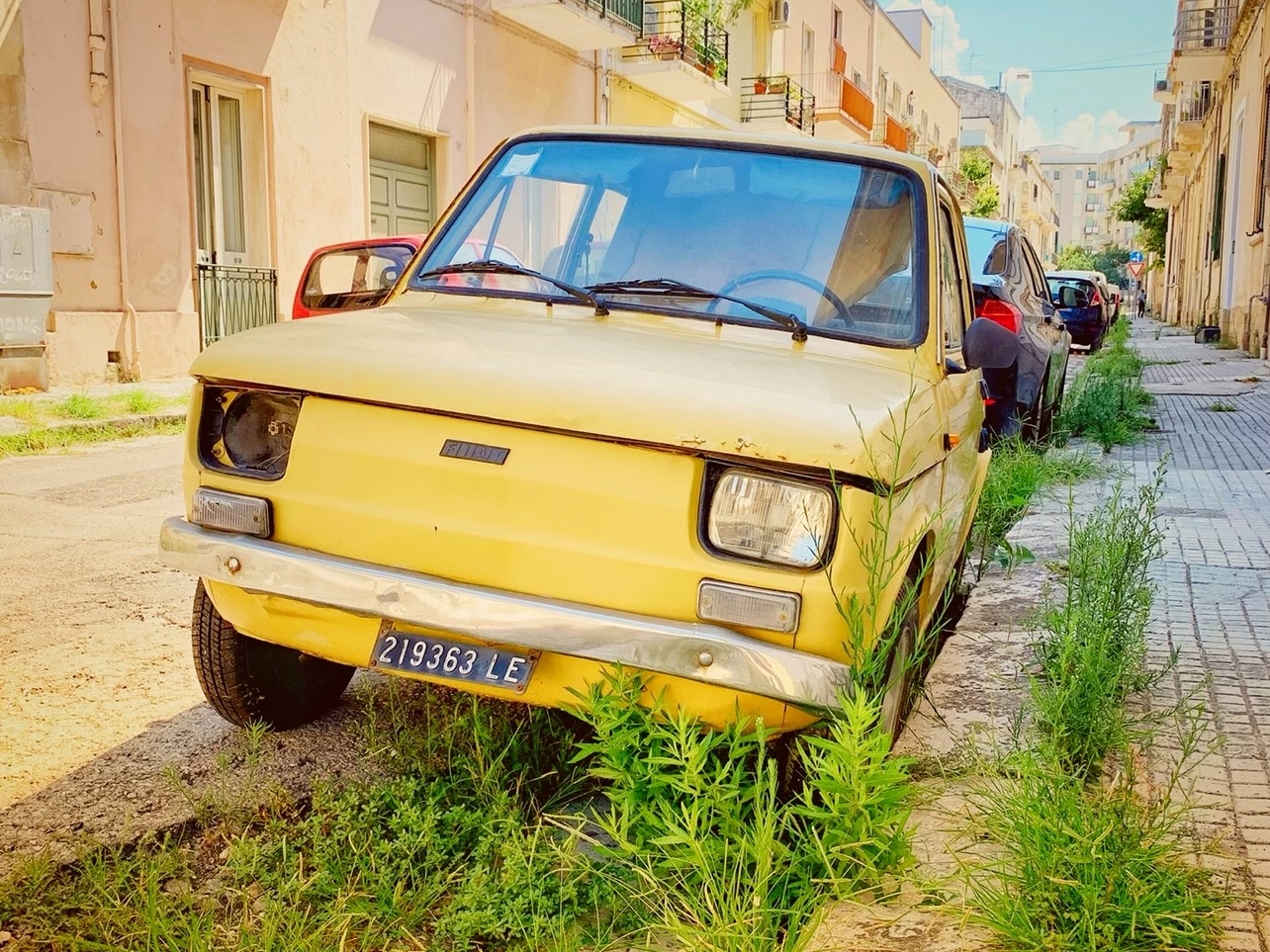
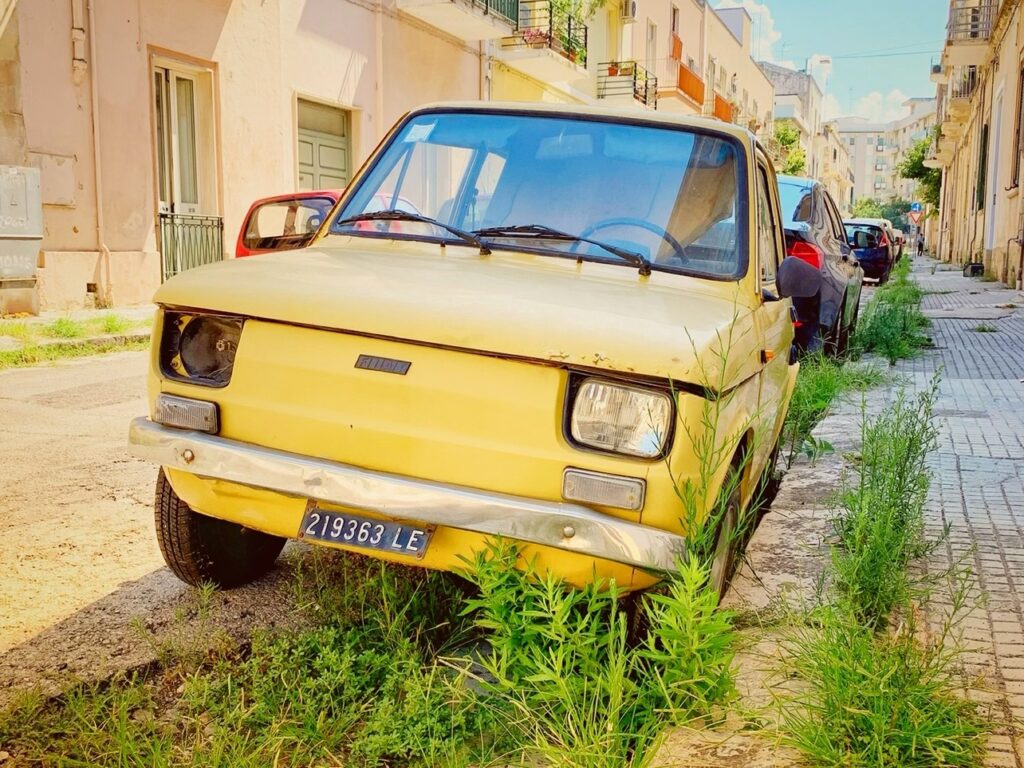
Hi LuigiMax, really helpful article, thanks. We are driving from Brindisi airport to Andrano on Sat 28/06 and we’re thinking of stopping in Lecce for lunch. What is it like driving in Lecce, please? Given it’s my first time driving in Italy, should we change the plan? 🤣
Ciao.
First, have you read Head Over Heel by Chris Harrison? Aussie traveller meets Italian girl in Dublin pub, falls in love and moves to live with her in Andrano. It’s a really well written book and it gives a real insight into life in this sleepy, sunny Salento town, and I think it would make for an excellent read for your time there. It really evokes life in summer in Salento (and the trials and tribulations of Italian bureaucracy). We think it might still be available on Amazon UK. I enjoyed it so much that I read it twice.
We don’t mind driving in Lecce, and in actual fact where we park it avoids driving through Lecce. You stay on the SS16 Adriatic Highway instead of turning off on the tangenziale to head south, then at the 2nd roundabout just after the bus station where you see a hotel, take the side filter at the roundabout, onto Viale dell’Università and we park just off there, where it’s a short walk to the old town. We describe it in more detail (with additional options) in our Puglia Guys Lecce Guide in the Where to Park section (with google map links). To continue you can go through Lecce or you just might prefer to head back the way you came to connect onto the Lecce Tangenziale to head south.
Our Driving in Puglia Guide gives you some information about the Lecce Tangenziale.
Heading to the parking we recommend really shouldn’t be more challenging than driving on the tangenziale south anyway. Just be prepared for the cars parked on both sides of narrow streets when you get into the side roads for free parking (so avoid them if you have a car jeep size or bigger). Of course you might prefer the pay parking we recommend. Just set your sat nav to wherever you choose to guide you for that last part (onto and from Viale dell’Università).
Driving in Puglia isn’t as difficult as the reputation Italy has from other places (Rome, Naples, Amalfi), so take assurance from our driving guide, and don’t be put off by the bad habits, just be aware of them so you know what to expect.
Hope that helps and reassures!
Enjoy Andrano and that whole section of coast. We love the coastal drive from there to Santa Maria di Leuca.
LuigiM.
Hi LuigiMax, how bad will it be driving from Bari(near central station) to Fasano with a stop to visit Polignano a Mare (and maybe Monopoli if not too hectic) on August 15 (of all days!!) this year, and what should we expect regarding parking in Polignano a Mare on that day? At what time should we leave Bari to avoid traffic peak? On the other hand, we’re maybe considering staying in Bari instead just to avoid the traffic – how is Ferragosto celebrated in Bari?
Many thanks in advance!
Nataly
Woohoo! Yup, you’re pretty much there already. The big summer holiday is marked by beach outings, family gatherings, and festive meals. Many locals and tourists flock to the coastline to enjoy the sea and sun. The peak of the peak time, and if we remember correctly it falls on Friday meaning it’s going to be one big and busy weekend!
Popular coastal towns – especially Polignano a Mare and Monopoli – will see a significant influx of visitors. We anticipate people will anticipate the traffic and try to leave early to beat it, and with people arriving early to secure spots, so it’s really hard to predict.
The roads around Bari, including the Tangenziale (ring road) and routes to coastal towns like Polignano a Mare, experience heavy traffic throughout August and this is the busiest of the busy days, and at normal times, the busiest road in Puglia we experience!! Expect a big the surge in traffic and delays. Delays!!!! The combination of local residents taking advantage of the holiday and tourists visiting the region contributes to crowded roads and that’s not even the challenge of parking with what might feel like all of Italy there.
Beach, concerts, picnic, fireworks. Late night celebrations and festivities.
If we had to travel on that day, fortunately the Bari to Polignano and Monopoli train line is a fantastic service, central stations and we’d book train tickets and seats, and if that’s how we’d travel there on Ferragosto.
Good luck!
LuigiM.
Is there an app best to use for navigating the area? I use Google Maps in the US, but not sure if it is accurate in Puglia. Thanks.
We use Google Maps on iPhone when needed.
LuigiM
Can you please recommend local car hire companies, my husband and I are spend a week in Puglia from 11th June.
Ciao Taryn. We all have our own transport and have very limited experience of car hire. Earlier this month we had friends visit who were happy with their experience from noleggiare.it/en/
Ciao LM
Sixt normally has the best rates,